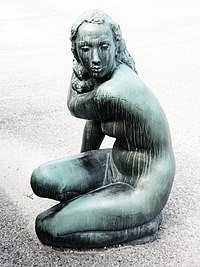 Marsden Hartley's 1941 painting of "Lobster Fishermen" inspired by fishermen from his home state of Maine. | |
| Years active | Beginning in the 1930s, reaching a height in the 1950s-1960s, but with practitioners still working in the style today |
|---|---|
| Location | United States |
| Major figures | Artists Max Weber, Marsden Hartley, Milton Avery, Edwin Dickinson |
| Influences | German Expressionism is the most direct influence, but representational painting has roots in Old Master and history painting |
New York Figurative Expressionism is a visual arts movement and a branch of American Figurative Expressionism. Though the movement dates to the 1930s, it was not formally classified as "figurative expressionism" until the term arose as a counter-distinction to the New York–based postwar movement known as Abstract Expressionism.[1]
Commenters like Museum of Contemporary Art of Detroit (MOCAD) curator Klaus Kertess observed that "[o]n the eve of the new abstraction's purge of figuration and its rise to all-encompassing prominence, the figure began to acquire a new and forceful vigor,"[2] elsewhere explaining that "[d]uring the late forties and early fifties," figurative work was associated with a conservatism abstractionists sought to avoid. Their response was defensive, and "prone to blur the vast distinctions between figurative painters and to exaggerate the difference between the figurative and the nonfigurative. It was not until the late sixties and early seventies that the figure was permitted to return from exile and even to make claims to centrality."[3] But that was not true of all abstract expressionists. Willem de Kooning (1904–1997) and Jackson Pollock (1912–1956), for example, started incorporating figurative elements far sooner.[4] They, along with abstract expressionist Conrad Marca-Relli (1913–2000) among others, built upon the figure as a framework for expanding their otherwise abstract canvases.[2]
Early New York figurative expressionists included Max Weber (1881–1961) and Marsden Hartley (1877–1943), known for their work with myth and spirituality. Other early practitioners spanned the lyrical restraint of Milton Avery (1885–1965) and the clear, direct work of Edwin Dickinson (1891–1978).
- ^ Lafo, Rachel; Capasso, Nicholas; Uhrhane, Jennifer (2002). Painting in Boston, 1950-2000. Amherst, MA: University of Massachusetts Press. p. 171. ISBN 1558493646.
- ^ a b Paul Schimmel and Judith E Stein, The Figurative fifties : New York figurative expressionism, Introduction (Newport Beach, Calif.: Newport Harbor Art Museum: New York : Rizzoli, 1988.) ISBN 978-0-8478-0942-4
- ^ Paul Schimmel and Judith E Stein, The Figurative fifties : New York figurative expressionism, The Other Tradition (Newport Beach, Calif. : Newport Harbor Art Museum : New York : Rizzoli, 1988.)ISBN 978-0-8478-0942-4 p.17
- ^ Dubin, Zan (Jul 17, 1988). "Expressionism's Zigzag in '50s New York: It Figured". Los Angeles Times.


